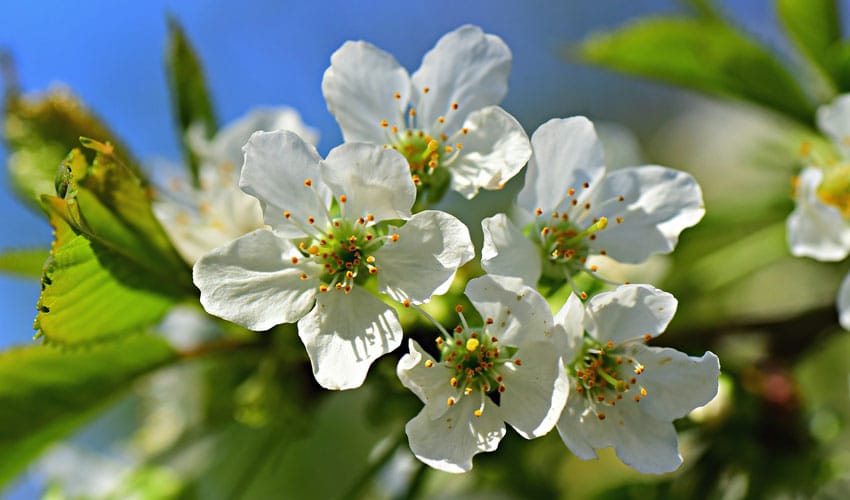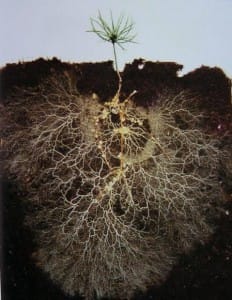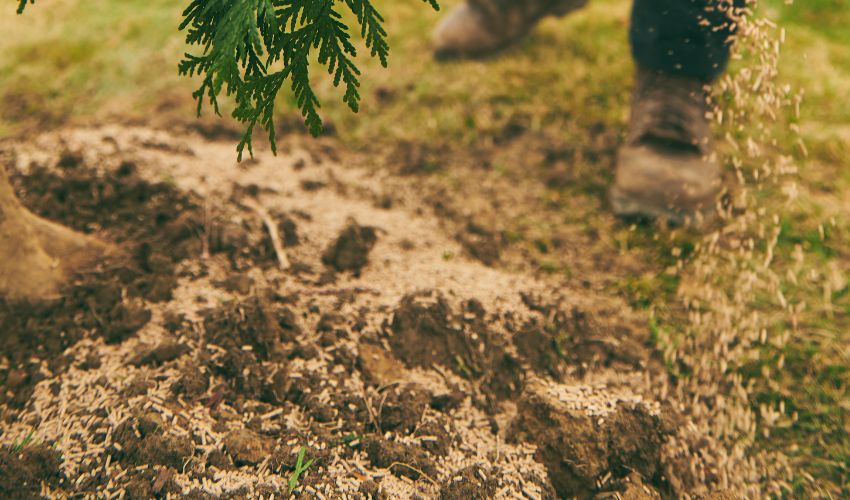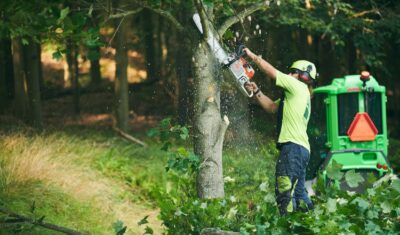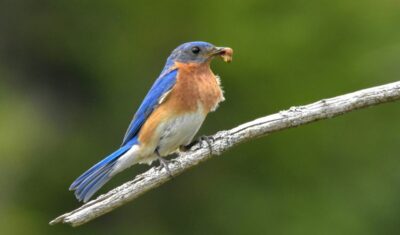Spring is the perfect time to fertilize trees in Northeast Ohio, particularly if you didn’t fertilize them in fall. Replenishing the soil with essential nutrients early in spring, before they start actively growing, gives trees the necessary resources to support healthy growth and development throughout the year. Fertilizing in spring can also help trees recover from any stress caused by harsh winter conditions, improving their overall health and vigor.
In this comprehensive guide, we’ll cover the benefits, best practices, and common mistakes to avoid when fertilizing your trees this spring.
Why Spring Fertilization Matters
Recovery from Winter Damage
We often experience harsh winter conditions in Northeast Ohio that can take a toll on trees, causing injuries like cold and frost burn, damaged limbs, and salt burn. Fertilizing in spring helps trees recover from these setbacks and promotes their overall health and growth. This is especially true if they have suffered damage over consecutive years.
LEARN MORE > How late spring snow and cold affects trees
Nutrient Replenishment for Urban Trees
Urban environments can present many challenges for trees, with one of the most significant obstacles being poor soil quality. Often trees in urban environments need fertilization because many of the natural processes that normally take place to deliver nutrients to the soil are disrupted. Leaves are raked up, foot traffic compacts the soil, and the presence of pollutants can strip nutrients from the soil and disturb their absorption. As a result, urban trees often lack access to all of the nutrients needed for optimal health, leaving them stressed and more vulnerable to pests and diseases.
Spring fertilization replenishes these nutrients, reducing stress on urban trees and making them less vulnerable to pests and diseases. By enhancing soil quality, we can promote healthier urban tree populations, contributing to a greener and more sustainable future.
When choosing a fertilizer for trees in urban environments, it’s important to consider factors such as soil type, tree species, and existing soil nutrient levels. Ideally, the fertilizer should contain a balanced blend of macronutrients like nitrogen, phosphorus, and potassium, as well as micronutrients like iron, manganese, and zinc. We also recommend using slow-release fertilizers, as they provide a steady supply of nutrients over a more extended period, reducing the risk of over-fertilization.
LEARN MORE > All about soil health
Supporting Young Tree Growth
Winter can be tough on newly planted or recently transplanted trees, with cold temperatures and frozen soil limiting their ability to absorb nutrients. By fertilizing in spring, you’re ensuring that these young trees and transplants have access to the essential elements they need to support their growth and overall health.
Spring fertilization can also help young trees and transplants overcome any stress or shock they may have experienced during the planting process. Moving trees from one location to another disrupts their root systems and makes it challenging for them to take up nutrients. By providing them with a well-balanced fertilizer in spring, you’re giving them a head start in recovering from any transplant shock and helping them establish and thrive.
Mitigating Construction Impact
Trees near construction sites can suffer root damage, compaction, and soil suffocation, leading to nutrient deficiencies. Fertilizing these trees in spring helps them cope with the stress caused by construction activities and supports their growth during the challenging season.
Have you had construction done anywhere around your trees or shrubs? Tree root systems extend a long distance, well past the canopy or drip line of the tree. Digging, compaction from equipment, exposure to the elements, and soil suffocation are ways that construction damages these vital roots and puts stress on trees as they struggle to absorb nutrients. Think of these trees as being immune-compromised and, as such, they can benefit from some added nutrients to get them through the tough growing season ahead of them.
If you are planning construction around your home, please review our article on avoiding damage to trees during construction. Construction can be life-threatening to a tree and it is vital to protect them from damage.
LEARN MORE > Our complete set of fertilization FAQs
Enhancing Blossoms & Fruit Growth
Fruit trees in Northeast Ohio need an application of fertilizer every spring to produce the best harvest. Fertilization needs will vary based on your soil type so it’s a good idea to conduct a soil test every 2 to 3 years to see what your trees really need. Fruit trees are typically fertilized each spring with a dry fertilizer broadcast under the tree drip line. Do not over-fertilize your fruit trees! Too much fertilizer will produce lots of leaves but little fruit.
If your trees or shrubs have any of the above issues, please call us at 440-564-1374 or contact us online to schedule your spring fertilization.
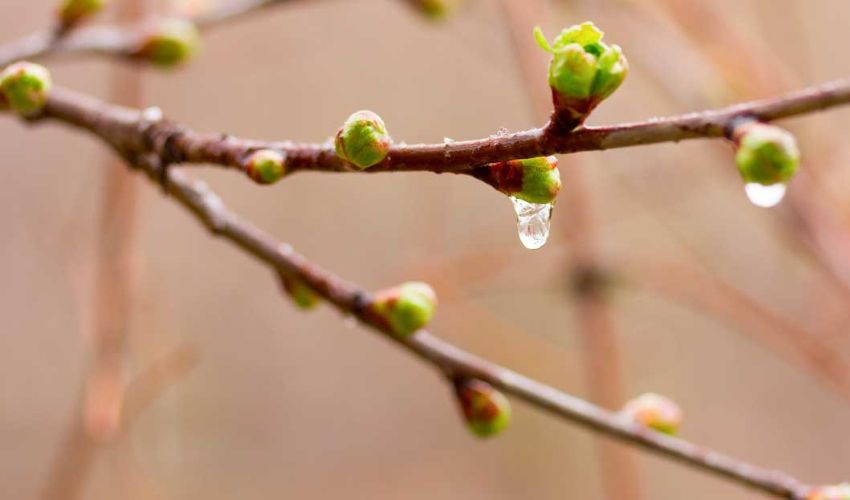
Benefits of Spring Fertilization for Trees
Fertilizing trees in spring offers numerous benefits to trees that enhance their aesthetic appeal and promote overall tree health and longevity. And healthy trees contribute to a healthier environment by improving air quality, providing shade, and supporting wildlife habitats.
Some key advantages of spring tree fertilization include:
- Replenished Nutrients: Fertilizing in spring ensures that trees receive essential nutrients, supporting new growth, improved health, and vibrant tree color.
- Improved Tree Health: Fertilization helps trees develop a strong root system, enabling better water uptake, nutrient absorption, and utilization, leading to healthier and more resilient trees that are better prepared to withstand summer stressors, such as drought or pest infestations.
- Enhanced Growth: Young trees fertilized in spring tend to grow faster and more successfully, promoting their development and overall vigor. Within a few weeks to a couple of months, you may notice increased shoot growth, denser canopy development, and increased vigor in the tree.
- Boosted Curb Appeal: Lush and thriving trees not only enhance the beauty of your property with beautiful foliage, vibrant flowers, and healthy fruits, but also increase its value, making spring fertilization a worthwhile investment.
- Prevention of Nutrient Deficiencies: Fertilizing in spring ensures that trees have the necessary nutrients to support growth, flowering, and fruiting throughout the year, preventing any deficits that could hinder their development.
- Optimal Timing: Spring is an ideal time for fertilization as trees are actively growing and can benefit greatly from the added nutrients to support their seasonal growth cycle.
Do Your Trees Really Need Spring Fertilization?
Before fertilizing your trees, it’s essential to recognize the signs that indicate a need for additional nutrients. While you can’t evaluate these during winter, think back to last year’s growing season. If you noticed these signs, your trees will likely benefit from fertilization this spring:
- lack of growth,
- yellowish leaves,
- shrinking leaf size,
- early autumn leaf color change, and
- dead branches or tips.
If you’re unsure about the nutrient needs of your trees and shrubs, we recommend having a professional soil test to identify any deficiencies and recommendations to improve soil quality. The Ohio State University Extension Service recommends that residents in Cuyahoga, Geauga, and other Northeast Ohio counties use the UMass Soil and Plant Nutrient Testing Lab because they offer comprehensive soil tests.
Common Spring Fertilization Mistakes to Avoid
While spring fertilization can be highly beneficial for your trees, it’s important to avoid common mistakes that can potentially harm their health. Here are some pitfalls to watch out for:
- Using the Wrong Type of Fertilizer: Different tree species have varying nutrient requirements, and using the wrong kind of fertilizer can have negative effects. It’s a good idea to consult with local arborists to understand the specific needs of your trees before applying fertilizer.
- Over-fertilization: Over-fertilization can lead to issues like brown leaf edges, yellow, limp leaves, leaf drop, and other symptoms that mimic nutrient deficiency. Always follow the instructions on the fertilizer label carefully to prevent over-fertilization.
- Applying Fertilizer at the Wrong Time: Trees and shrubs need fertilizer at specific points in their annual growth cycles for it to be effective. Applying fertilizer at the wrong time is not only ineffective (and a waste of money), it can even be harmful to trees.
- Surface Fertilizing: Surface fertilizing may not effectively deliver nutrients to tree roots where they are needed most. Deep root fertilization injections are a more efficient method, delivering nutrients directly to the depth where tree roots are growing.
By following best practices and avoiding these common mistakes, you can ensure that your spring tree fertilization efforts are effective and beneficial for the long-term health and vitality of your trees.
Trust the Experts at Independent Tree
If you notice that your trees look unhealthy this spring or aren’t growing well after you’ve applied fertilizer in spring, it’s a good idea to have a local Northeast Ohio arborist, like Independent Tree, inspect them. We often see trees that have been improperly fertilized (including many that have never received a fertilization treatment at all) and can make recommendations to remediate whatever issues you’re experiencing.
At Independent Tree, we understand the importance of proper tree care in the Chagrin Valley area. Our team of certified arborists and tree health professionals is dedicated to providing exceptional tree care services, including professional spring fertilization tailored to the specific needs of your trees. Call us today at 440-564-1374 to schedule a consultation and give your trees the nourishment they need to thrive this spring and beyond.
Your Trees Need Fertilization!
Now that you know the reasons why trees in urban and suburban environments need fertilization, don't forget to schedule your fertilization applications this spring. Contact the Independent Tree office for more information or to guarantee your spot on the schedule.Recent Articles
Topics
About The Author

STAY IN THE LOOP
WITH OUR
LATEST UPDATES
"*" indicates required fields

